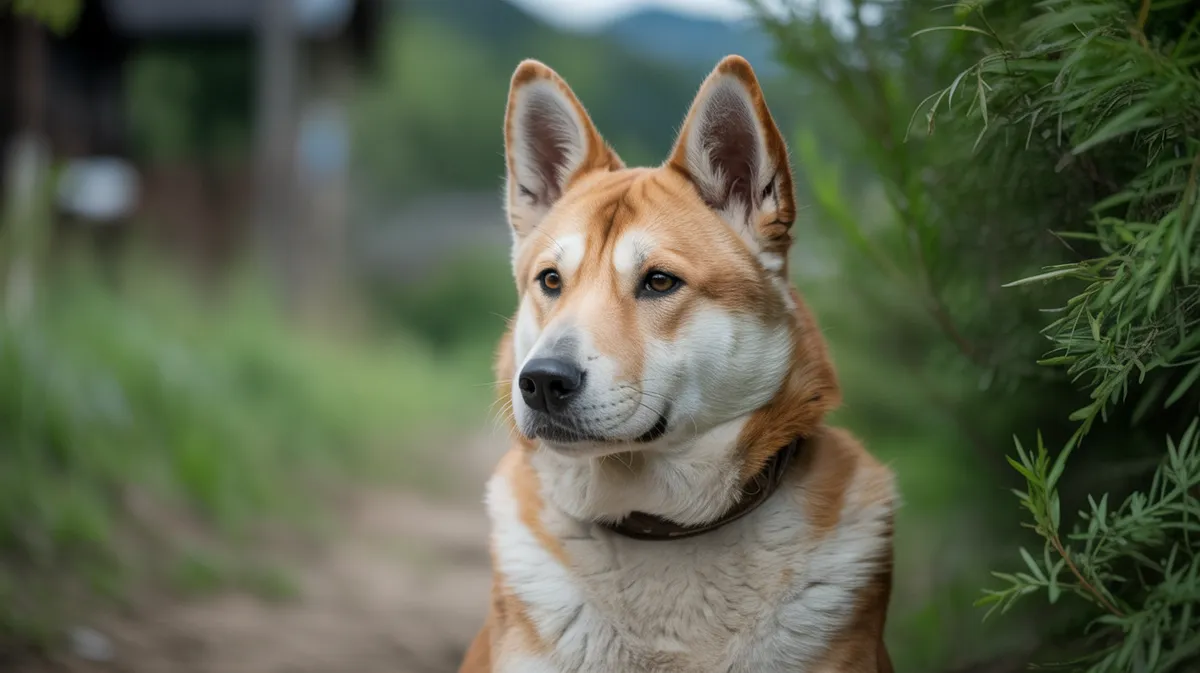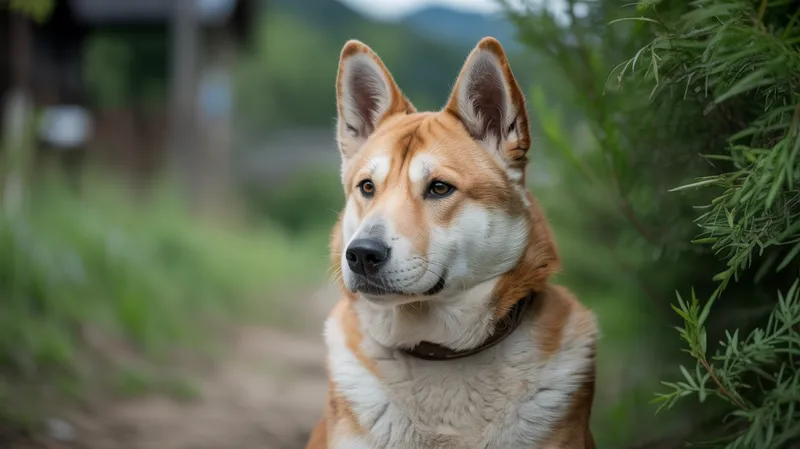
Korean Jindo Dog
Canis lupus familiaris

Meet the Korean Jindo Dog
The Korean Jindo Dog is a medium-sized spitz-type breed native to Jindo Island in South Korea, known for its loyalty, intelligence, and strong hunting instincts. This breed is celebrated for its clean habits, keen sense of direction, and remarkable devotion to its owners, often forming a close bond with one person or family. Jindos have a double coat that can come in a range of colors, including white, fawn, black, tan, and brindle, and are well-adapted to both rural and urban environments. Highly independent and sometimes aloof with strangers, the Jindo is a versatile breed used for hunting, guarding, and companionship. Due to its strong prey drive and territorial nature, early socialization and consistent training are essential for this breed.
Classification
Mammal
Habitat
Domestic environment, rural and urban settings, originally mountainous and forested areas
Diet
Omnivore
Lifespan
12-15 years
Conservation
Least Concern
Weight
15-23 kg
📖Fascinating Facts
Loyal Guardian
Jindos are deeply devoted to their families and make excellent watchdogs due to their strong protective instincts.
Homing Instinct
These dogs possess an extraordinary sense of direction and have been documented finding their way home over incredible distances.
National Treasure
The Korean Jindo Dog is recognized as Natural Monument No. 53 and is protected by the Korean government as a cultural heritage breed.
📋Detailed Description
The Korean Jindo Dog is a medium-sized, well-proportioned spitz-type breed, typically weighing between 18–23 kg (40–51 lbs) for males and 15–19 kg (33–42 lbs) for females, with males standing 50–55 cm (20–22 in) at the shoulder and females 45–50 cm (18–20 in). The breed is characterized by a wedge-shaped head, erect triangular ears, almond-shaped dark eyes, and a bushy, sickle-shaped tail carried over the back. Jindos possess a dense double coat with a harsh, straight outer layer and a soft, insulating undercoat, which provides protection against harsh weather and temperature extremes. Their coat colors include red fawn, white, black, black and tan, wolf grey, and brindle, with lighter undercoats. Anatomically, Jindos are agile and muscular, built for endurance and speed, reflecting their origins as hunters in rugged, mountainous terrain. Behaviorally, they are renowned for their intelligence, independence, and strong territorial instincts, often displaying reserved or aloof behavior toward strangers but deep loyalty to their primary human companions. Social structure within the breed tends to be hierarchical, with clear dominance relationships, especially among males. Jindos are known for their exceptional homing ability, able to return over great distances to their owners. Reproductively, they have a single annual estrus cycle, with litters typically ranging from 4–8 pups. Their keen senses, particularly olfaction and hearing, are highly developed, supporting their historical roles in hunting and guarding. The breed is noted for its clean habits, minimal doggy odor, and tendency to self-groom, contributing to its reputation as a low-maintenance companion.
💡 Did you know?
Jindos are so loyal that some have reportedly refused food from strangers, waiting days or weeks for their owners to return.
🔬Research & Sources
Wikipedia Summary
The Jindo dog is an indigenous dog native to the island of Jindo in South Korea. It is also known as Jindo-gyeon (진도견) and formerly known as the Chindo dog.
Last Modified: 5/23/2025
🎭Behavior & Social Structure
Korean Jindo Dogs are highly intelligent, independent, and vigilant, exhibiting a strong prey drive and territoriality. They are natural hunters, historically used to pursue game such as deer, boar, and small mammals, often hunting silently and relying on keen senses of smell and sight. Jindos are known for their single-minded focus during hunts and their ability to track and return with prey. Socially, they form close bonds with their primary caregivers but may be aloof or reserved with strangers and other animals, sometimes displaying same-sex aggression. Daily routines include patrolling their territory, alert barking at unfamiliar stimuli, and engaging in self-directed play or exercise. They require significant mental and physical stimulation to prevent boredom-related behaviors. Jindos are also noted for their cleanliness, often choosing specific spots for elimination and grooming themselves like cats. Their loyalty can manifest as protectiveness, and they may act as effective watchdogs, alerting owners to intruders or unusual activity.
👶Reproduction & Life Cycle
The Korean Jindo Dog is a monoestrous breed, with females typically coming into heat once per year, usually in late winter or early spring. The estrus cycle lasts about 2–3 weeks, during which females may exhibit increased vocalization and scent marking. Mating is usually selective, with both sexes displaying courtship behaviors such as circling, sniffing, and play bowing. Gestation lasts approximately 58–63 days, after which the female gives birth to a litter of 4–8 pups. Maternal care is pronounced; the dam is attentive, providing warmth, grooming, and protection to her offspring. Pups are weaned at around 6–8 weeks and begin to exhibit early social behaviors and hunting instincts. Breeding is traditionally managed to preserve the breed's purity and working traits, with strict selection for temperament, health, and physical conformation. In South Korea, the breed is protected by law, and exportation is regulated to maintain genetic integrity.
🛡️Adaptations & Survival
Jindos have evolved several adaptations suited to their original environment on Jindo Island. Their double coat provides insulation against cold and wet conditions, while the harsh outer layer repels dirt and moisture. The breed's muscular, agile build and strong hindquarters enable them to traverse rugged, mountainous terrain with ease. Their acute senses of smell and hearing are specialized for tracking and detecting prey over long distances. Behaviorally, their independence and problem-solving abilities allow them to make decisions without constant human direction, a trait valued in hunting and guarding roles. The breed's strong homing instinct is a unique adaptation, with documented cases of Jindos returning to their owners from hundreds of kilometers away, likely utilizing a combination of olfactory, visual, and geomagnetic cues. Their reserved nature and territoriality serve as protective mechanisms, reducing risk from unfamiliar animals or humans.
📚Research Sources
🎨Cultural Significance
The Korean Jindo Dog holds significant cultural importance in South Korea, where it is designated as Natural Monument No. 53 and regarded as a national treasure. The breed symbolizes loyalty, courage, and fidelity, with numerous folk tales and legends celebrating its devotion—most famously, stories of Jindos returning to their owners over great distances. Jindos have been depicted in Korean art, literature, and postage stamps, and are often featured in national ceremonies and festivals. Traditionally, they were used for hunting and guarding, and their image is associated with protection and good fortune. The breed's export is tightly regulated by the Korean government to preserve its heritage. In recent years, the Jindo has become an ambassador for Korean culture abroad, with dedicated breed clubs in North America and Europe.
🔬Recent Research & Discoveries
Recent genetic studies have focused on the Jindo's unique lineage, revealing low genetic diversity compared to other spitz-type breeds, likely due to geographic isolation and selective breeding on Jindo Island. Behavioral research has highlighted the breed's advanced problem-solving skills and strong attachment behaviors, with ongoing studies examining the genetic basis of their homing instinct. Health surveys indicate the breed is generally robust, with low incidences of hereditary diseases, though hip dysplasia and hypothyroidism have been reported at low frequencies. Conservation genetics research is ongoing to monitor inbreeding and maintain genetic health. Internationally, studies are examining the breed's adaptability to urban environments and the impact of early socialization on temperament.
🎥Wildlife Videos

DISCOVER THE KOREAN JINDO: NATURE'S FEARLESS HUNTER
The Korean Jindo dog, known for its loyalty and strong-willed nature, is a distinct breed from Jindo Island in South Korea.
Dogumentary TV

Wildlife - Just Wild Dogs | Free Documentary Nature
Wildlife - Episode 7: Just Wild Dogs | Wildlife Documentary Watch 'Wildlife - Episode 8' here: https://youtu.be/kglJpB4ei8o Run ...
Free Documentary - Nature

Wild Canada - Nature's Untamed Beauty | Full Series | Free Documentary Nature
Wild Canada - Nature's Untamed Beauty | Wildlife Documentary Watch 'Darkwoods - Canada's Hidden Nature Reserve' here: ...
Free Documentary - Nature

The Incredible Korean Jindo: Nature's Perfect Dog
In this video, we'll introduce you to Korean Jindo, a famous hunting dog breed. Korean Jindo is a dog breed that is known for its ...
Dogumentary TV
![Wild Dogs | National Geographic Wild Documentary [Full HD 1080p]](https://i.ytimg.com/vi/hLzJQMSZsBc/maxresdefault.jpg?sqp=-oaymwEcCOADEI4CSFXyq4qpAw4IARUAAIhCGAFwAcABBg==&rs=AOn4CLABKfWTL-ZIYEVrePsxEbJTAP4Hag)
Wild Dogs | National Geographic Wild Documentary [Full HD 1080p]
Wild Dogs | National Geographic Wild Documentary [Full HD 1080p] #wildplanet #wilddogs #documentary ----------------------- The ...
Wild Planet

Wildlife Instincts: A Family Bond - Dingoes | Free Documentary Nature
Wildlife Instincts - Episode 5: A Family Bond - Dingoes | Free Nature Documentary Watch "Wildlife Instincts: Pallas's Cat - Master ...
Free Documentary - Nature
🌍Habitat Information
The Korean Jindo Dog typically inhabits Domestic environment, rural and urban settings, originally mountainous and forested areas environments. Korean Jindo Dogs have adapted to their environments with specialized features and behaviors.
Primary Habitat:
Domestic environment, rural and urban settings, originally mountainous and forested areas
More detailed habitat information will be available soon.
🛡️Conservation Status
The Korean Jindo Dog is currently classified as Least Concern. Conservation efforts are crucial for preserving this species for future generations.
Common Threats:
- 🏠Habitat loss and fragmentation
- 🌡️Climate change impacts
- 🎯Hunting and poaching
- 🏭Human-wildlife conflict
⚠️Threats & Conservation Challenges
The Korean Jindo Dog is not currently considered at risk globally, but several challenges affect the breed. Genetic dilution through crossbreeding, especially outside Korea, threatens breed purity. Urbanization and changing lifestyles in South Korea have reduced the traditional roles of Jindos, leading to decreased demand and potential loss of working traits. There is also a risk of overpopulation in some regions due to unregulated breeding. In South Korea, the breed is protected as a national treasure, with strict export controls and breeding regulations. Internationally, Jindos may face challenges adapting to environments where their strong prey drive and independence can lead to behavioral issues if not properly managed. Despite these challenges, the breed's population remains stable, with active conservation and breed clubs working to preserve its unique characteristics.
🔬Scientific Classification
Scientific Name
Canis lupus familiaris
Classification Hierarchy
🔍 About Taxonomic Classification
Taxonomic classification is a hierarchical system used by scientists to classify and organize living organisms based on shared characteristics and evolutionary relationships.
The system moves from broad categories (Kingdom) to increasingly specific ones, with each animal's scientific name typically consisting of its Genus and species.
📝Community Notes
Share your observations and insights about the Korean Jindo Dog with our community of wildlife enthusiasts.
Join Our Community
Sign in to share your observations and connect with fellow wildlife enthusiasts.
Sign In to ContributeNo community notes yet
Be the first to share your observations about the Korean Jindo Dog!
Explore Korean Jindo Dog
Select a tab above to learn more about this amazing animal.
📸Photo Gallery
No photos available for this animal yet.
🌟Discover More Wildlife
Continue your journey of discovery with more fascinating animals from our database
